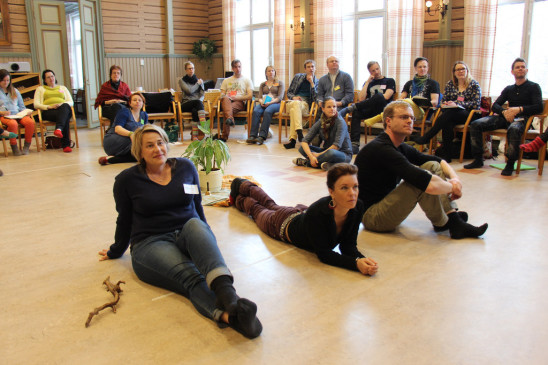 Last week I had a chance to participate in an Art of Hosting training in Otavan Opisto, Mikkeli.
Last week I had a chance to participate in an Art of Hosting training in Otavan Opisto, Mikkeli.
The hosts did a fantastic job in making everyone feel welcome and establishing an open environment for learning. Actually, the first thing that the organisers made clear was that the participants would be the hosts, and we would be learning about hosting while doing it. The different tasks one could sign up for included Harvesting (documentation), Feng Shui (arranging & cleaning the space, organising food & coffee, etc), Check In & Check Out (tuning into learning sessions, and tuning out from them), creating the programme for the evening party and or course hosting the actual learning sessions.
I came to the event to learn some more facilitation methods (and to gain a better understanding of methods I’m already familiar with), but I actually learned something else – various frameworks for getting a better grip of the community learning process as a whole, and to understand the process of personal growth and how human-to-human communication works (or fails to work).
Below you can find my own personal notes about my key learnings. These notes are rather sketchy, plenty of more information is available at:
- Art of Hosting site: www.artofhosting.org
- Art of Hosting Community site: artofhosting.ning.com
- Art of Hosting Workbook
The images are either from Art of Hosting Finland Flickr archive or from my Art of Hosting visual notes (mostly focusing on things written down by Estève Pannetier).
It was lovely event, thanks a lot for the organisers & all the participants!
– – – – –
WHAT DID I LEARN AT ART OF HOSTING?
:: Networks are good for rapid information sharing (but *not* for anything else)
No one actually made this exact statement, but there were several discussions about the different structures that one can utilize, and often one needs a combination of different structures (CIRCLE – HIERARCHY – NETWORK – MATRIX). I realised that I’ve previously tried to make networks do what networks are not good at, and thus these efforts have often been in vain.
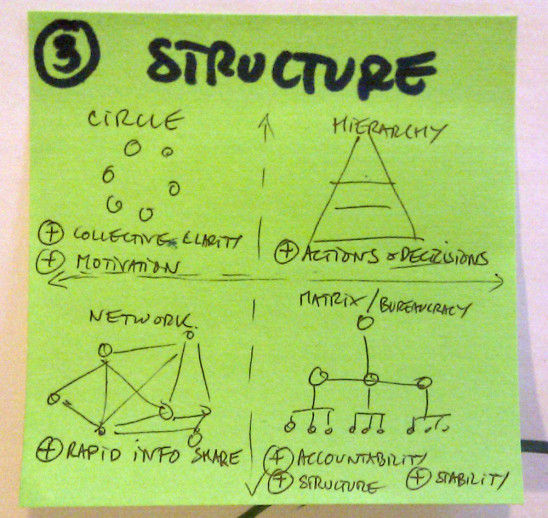
Photo: Four different structures (Estève’s notes)
:: Talking piece + Raising hands
When you are holding the talking piece, it’s your turn to talk and for others to listen. Good for calming things down, giving everyone a chance to speak. Related to circle practice.
Raising your hand: asking for silence. People raise their hand when they see a raised hand, the message spreads like a domino effect, no need for anyone to shout.

Photo: Talking pieces @ Art of Hosting
:: The Four Fold Path
1. Host Yourself
2. Be Hosted
3. Host Others
4. Be Part of a Community (that hosts itself)
:: Death and Birth
In the training, a lot of emphasis was put on ‘letting go’, ‘being out of one’s mind’, ‘death & birth’… In order to learn something new, we need to let go of something old.
This is related to Theory U – https://www.presencing.com/tools/u-journaling
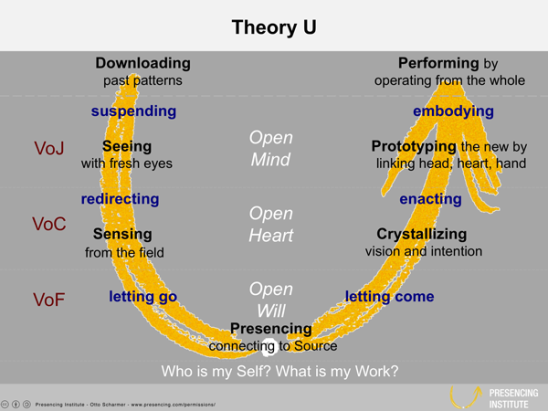
:: Check In & Check Out
There always should be a moment where the group collectively tunes into a learning moment, and in the end tunes out.
:: Non-Violent Communication
(as introduced by Estève)
1. Facts / Observations
2. Feelings
3. Needs
4. Request
If person A has a conflict with person B, then person A first goes through this list (1-2-3-4) and then person B does the same.
In point 2 (feelings), it’s important to take ownership and responsibility of one’s own feelings, and not blame others for causing them (in general: suspending assumptions and projections).
More information: http://en.wikipedia.org/wiki/Nonviolent_Communication#Four_components

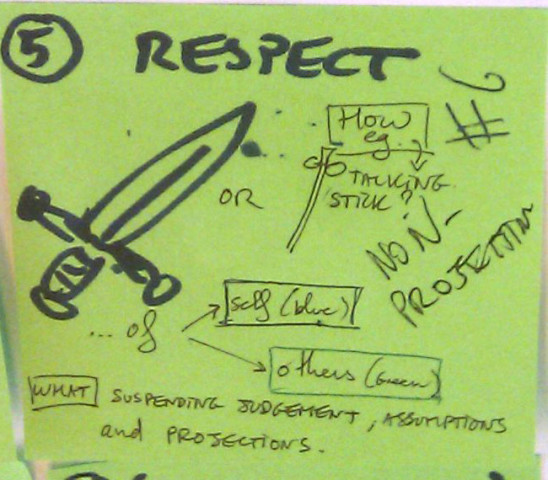
:: Green Blue Red
Related to Non-Violent Communication, would be interesting to learn more about this.
http://www.estevepannetier.com/green-blue-red
:: Open Space Technology
– Open Space is a *marketplace of ideas*.
– Structure vs Content: In Open Space Technology, the structure of the event is very strictly defined, so that chaos can emerge in the content
:: Three Thumbs consensus process (via Estève)
(This seems like a great alternative to basic voting)
– UP means “I’m good with it.”
– SIDEWAYS means “I need more clarity before I give the thumbs up”
– DOWN means “I have an alternative proposal”
Key thing is that thumb DOWN does not mean ‘I’m against this’, it means that the person has (*must have*) an alternative proposal.
:: Hosting vs Facilitation
It’s important to understand the difference between hosting and facilitation. A host is like a host of a dinner – the person that makes sure that everyone feels comfortable, but does *not* try to keep the discussions on a specific track. (At HIAP we probably need to understand better the difference between three things: Hosting / Facilitation / Networking)
:: Human – Boat Metaphor
Body = Boat
Mind = Captain
Feelings = Waves
Spirit = Weather
:: “How Might We…” aka HMW Questions (via Ville)
How to come up with great questions to trigger inquiries and action?
One thing to try out is by starting the question by “How Might We…”. A relevant link: http://amorebeautifulquestion.com/beginning-great-questions-how-might/
A quote from Einstein: “If I had an hour to solve a problem and my life depended on the solution, I would spend the first 55 minutes determining the proper question to ask, for once I know the proper question, I could solve the problem in less than 5 minutes.”
:: ‘Just’ is a dangerous word (session with Andy)
Example: ‘Can you just make a short video documentation of this event?’.
:: Stating the obvious every week (session with Andy)
Starting each week by stating the obvious – the things/goals that have been agreed upon together.
:: Nuffield Physics
Learning physics by first making practical experiments, and only afterwards learning the theory. (Note: I’ve been teaching software design in the same way)

:: The Groan Zone
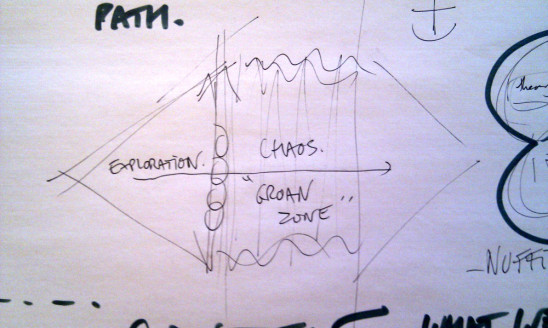
:: The Building Blocks
Estève & co are working on a set of building blocks that should be taken into account when designing a learning situation.

:: World Cafe
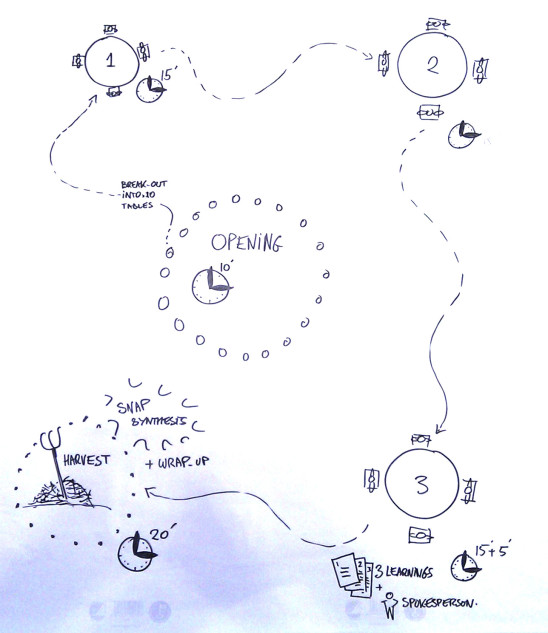

:: Snap Synthesis
A very quick method to structure the results of a World Cafe session.
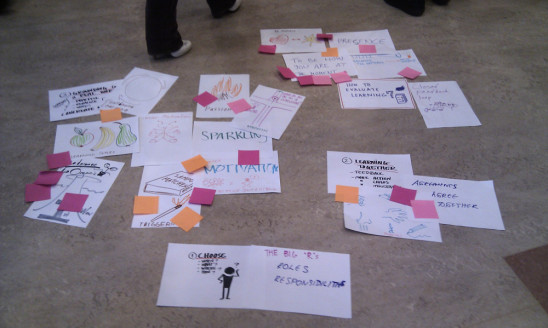
– – – –
LINKS:
- Art of Hosting training in Otavan Opisto, Mikkeli
- Art of Hosting: www.artofhosting.org
- Art of Hosting Community Site: artofhosting.ning.com

Pingback: The Art of Hosting | Structure & Process | Collaboration Consultants
Hello,
great harvest you have put here! (I wonder if you are part of the AoH Facebook group, it would make a lot of sense to post a link there too!)
I have one big observation, as a year long practitioner of AoH, that networks are good for innovation! when you let all the information and knowledge flow and cross-fertilize. what actually happens in a World Café or in an Open Space; but the sharing is essential.
Hosting a conversation is different than hosting a network… it all depends what is the purpose of your hosting… is it information sharing? is it novel insights? is it emergence of new practices and insights???
Pingback: Art of Hosting Finland - Methods, Questions, People, Thoughts and Inner Smile
Pingback: Art of Hosting Finland – Methods, Questions, People, Thoughts and Inner Smile | Techno Foundry